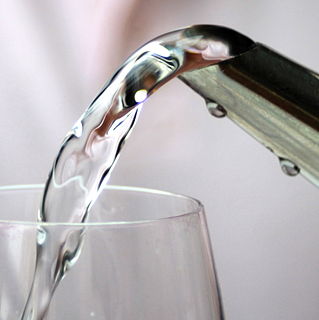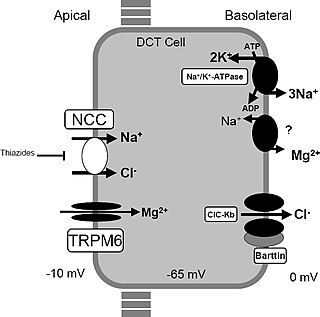Related Research Articles
An electrolyte is a medium containing ions that is electrically conducting through the movement of those ions, but not conducting electrons. This includes most soluble salts, acids, and bases dissolved in a polar solvent, such as water. Upon dissolving, the substance separates into cations and anions, which disperse uniformly throughout the solvent. Solid-state electrolytes also exist. In medicine and sometimes in chemistry, the term electrolyte refers to the substance that is dissolved.

Diabetic coma is a life-threatening but reversible form of coma found in people with diabetes mellitus.

In physiology, dehydration is a lack of total body water, with an accompanying disruption of metabolic processes. It occurs when free water loss exceeds free water intake, usually due to exercise, disease, or high environmental temperature. Mild dehydration can also be caused by immersion diuresis, which may increase risk of decompression sickness in divers.
Hyponatremia is a low sodium concentration in the blood. It is generally defined as a sodium concentration of less than 135 mmol/L, with severe hyponatremia being below 120 mEq/L. Symptoms can be absent, mild or severe. Mild symptoms include a decreased ability to think, headaches, nausea, and poor balance. Severe symptoms include confusion, seizures, and coma.

Potassium hydroxide is an inorganic compound with the formula KOH, and is commonly called caustic potash.

Sports drinks, also known as electrolyte drinks, are functional beverages whose stated purpose is to help athletes replace water, electrolytes, and energy before, during and especially after training or competition, though their effects on performance in sports and exercise has been questioned.

A cramp is a sudden, involuntary, painful skeletal muscle contraction or overshortening associated with electrical activity; while generally temporary and non-damaging, they can cause significant pain and a paralysis-like immobility of the affected muscle. A cramp usually goes away on its own over a period of several seconds, or minutes. Cramps are common and tend to occur at rest, usually at night. They are also often associated with pregnancy, physical exercise or overexertion, age, in such cases, cramps are called idiopathic, because there is no underlying pathology. In addition to those benign conditions cramps are also associated with many pathologic conditions.
Heat exhaustion is a severe form of heat illness. It is a medical emergency. Heat exhaustion is caused by the loss of water and electrolytes through sweating.

Electrolyte imbalance, or water-electrolyte imbalance, is an abnormality in the concentration of electrolytes in the body. Electrolytes play a vital role in maintaining homeostasis in the body. They help to regulate heart and neurological function, fluid balance, oxygen delivery, acid–base balance and much more. Electrolyte imbalances can develop by consuming too little or too much electrolyte as well as excreting too little or too much electrolyte.

Hypokalemia is a low level of potassium (K+) in the blood serum. Mild low potassium does not typically cause symptoms. Symptoms may include feeling tired, leg cramps, weakness, and constipation. Low potassium also increases the risk of an abnormal heart rhythm, which is often too slow and can cause cardiac arrest.
A charley horse is a painful involuntary cramp in the legs and/or foot, lasting anywhere from a few seconds to a day. The term formerly referred more commonly to bruising of the quadriceps muscle of the anterior or lateral thigh, or contusion of the femur, that commonly results in a haematoma and sometimes several weeks of pain and disability. In this latter sense, such an injury is known as dead leg.

Water intoxication, also known as water poisoning, hyperhydration, overhydration, or water toxemia, is a potentially fatal disturbance in brain functions that results when the normal balance of electrolytes in the body is pushed outside safe limits by excessive water intake.

Gitelman syndrome (GS) is an autosomal recessive kidney tubule disorder characterized by low blood levels of potassium and magnesium, decreased excretion of calcium in the urine, and elevated blood pH. The disorder is caused by genetic mutations resulting in improper function of the thiazide-sensitive sodium-chloride symporter located in the distal convoluted tubule of the kidney. The distal convoluted tubule of the kidney plays an important homoestatic role in sodium and chloride absorption as well as of the reabsorption of magnesium and calcium.

Heat syncope is fainting or dizziness as a result of overheating. It is a type of heat illness. The basic symptom of heat syncope is fainting, with or without mental confusion. Heat syncope is caused by peripheral vessel dilation, resulting in diminished blood flow to the brain and dehydration.
Acute muscle soreness (AMS) is the pain felt in muscles during and immediately, up to 24 hours, after strenuous physical exercise. The pain appears within a minute of contracting the muscle and it will disappear within two or three minutes or up to several hours after relaxing it.
Heat illness is a spectrum of disorders due to environmental exposure to heat. It includes minor conditions such as heat cramps, heat syncope, and heat exhaustion as well as the more severe condition known as heat stroke. It can affect any or all anatomical systems.

Heat stroke or heatstroke, also known as sun stroke, is a severe heat illness that results in a body temperature greater than 40.0 °C (104.0 °F), along with red skin, headache, dizziness, and confusion. Sweating is generally present in exertional heatstroke, but not in classic heatstroke. The start of heat stroke can be sudden or gradual. Heatstroke is a life-threatening condition due to the potential for multi-organ dysfunction, with typical complications including seizures, rhabdomyolysis, or kidney failure.

The management of dehydration typically involves the use of oral rehydration solution (ORS). Standard home solutions such as salted rice water, salted yogurt drinks, vegetable and chicken soups with salt can be given. Home solutions such as water in which cereal has been cooked, unsalted soup, green coconut water, weak tea (unsweetened), and unsweetened fresh fruit juices can have from half a teaspoon to full teaspoon of salt added per liter. Clean plain water can also be one of several fluids given. There are commercial solutions such as Pedialyte, and relief agencies such as UNICEF widely distribute packets of salts and sugar. The World Health Organization (WHO) describes a homemade ORS with one liter water with one teaspoon salt and six teaspoons sugar added. The WHO; however, does not generally recommend homemade solutions as how to make them is easily forgotten. Rehydration Project recommends adding the same amount of sugar but only one-half a teaspoon of salt, stating that this more dilute approach is less risky with very little loss of effectiveness. Both agree that drinks with too much sugar or salt can make dehydration worse.
Exercise-associated muscle cramps (EAMC) are defined as cramping during or immediately following exercise. Muscle cramps during exercise are very common, even in elite athletes. EAMC are a common condition that occurs during or after exercise, often during endurance events such as a triathlon or marathon. Although EAMC are extremely common among athletes, the cause is still not fully understood because muscle cramping can occur as a result of many underlying conditions. Elite athletes experience cramping due to paces at higher intensities. The cause of exercise-associated muscle cramps is hypothesized to be due to altered neuromuscular control, dehydration, or electrolyte depletion.
Occupational heat stress is the net load to which a worker is exposed from the combined contributions of metabolic heat, environmental factors, and clothing worn which results in an increase in heat storage in the body. Heat stress can result in heat-related illnesses, such as heat stroke, hyperthermia, heat exhaustion, heat cramps, heat rashes and chronic kidney disease. Although heat exhaustion is less severe, hyperthermia is a medical emergency and requires emergency treatment, which if not provided can even lead to death.
References
- ↑ Auerbach Paul S Wilderness Medicine. 4th ed. St. Louis, Mo: Mosby; 2001:240-316.
- 1 2 3 Jacklitsch, Brenda L. (June 29, 2011). "Summer Heat Can Be Deadly for Outdoor Workers". NIOSH: Workplace Safety and Health. Medscape and NIOSH.